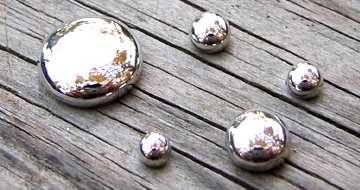
Mercury
Mercury General
| Name:Mercury | Symbol:Hg |
| Type:Transition Metal | Atomic weight:200.59 |
| Density @ 293 K:13.546 g/cm3 | Atomic volume:14.82 cm3/mol |
|
Discovered:
Mercury or quicksilver has been known since ancient times. Mercury was known to ancient Chinese and Hindus and has been found in Egyptian tombs dating back to 1500 B.C. The element's name comes from the Roman messenger god, Mercury, who was known for his speed and mobility. Its chemical symbol, Hg, is an abbreviation of the Latin word 'hydrargyrum', meaning liquid silver. |
|
Mercury States
| State (s, l, g):liquid | |
| Melting point:234.32 K (-38.83 °C) | Boiling point:629.88 K (356.73 °C) |
Mercury Energies
| Specific heat capacity:0.139 J g-1 K-1 | Heat of atomization:64 kJ mol-1 |
| Heat of fusion:2.295 kJ mol-1 | Heat of vaporization :59.229 kJ mol-1 |
| 1st ionization energy:1007 kJ mol-1 | 2nd ionization energy:1810 kJ mol-1 |
| 3rd ionization energy:3300 kJ mol-1 | Electron affinity: kJ mol-1 |
Mercury Oxidation & Electrons
| Shells:2,8,18,32,18,2 | Electron configuration:[Xe] 4f14 5d10 6s2 |
| Minimum oxidation number: 0 | Maximum oxidation number:2 |
| Min. common oxidation no.: 0 | Max. common oxidation no.:2 |
| Electronegativity (Pauling Scale):2 | Polarizability volume:5.4 Å3 |
Mercury Appearance & Characteristics
| Structure: rhombohedral | Color:silvery-white |
| Hardness:1.5 mohs | |
|
Harmful effects:
Mercury and most of its compounds are highly toxic. |
|
|
Characteristics:
Mercury is a dense, silvery-white, poisonous metal with a mirror-like appearance. The metal is relatively stable in dry air, but in moist air tarnishes slowly to form a gray oxide coating. Uses: Mercury is used in barometers and manometers (instruments for measuring the pressure of gases and liquids), because of its high density. |
|
Mercury Reactions
| Reaction with air:none, w/ht 350 °C ⇒ HgO | Reaction with 6 M HCl:none |
| Reaction with 15 M HNO3:mild, ⇒ Hg(NO3)2(mercuric nitrate), NOx | Reaction with 6 M NaOH:none |
Mercury Compounds
| Oxide(s):HgO (mercuric oxide), Hg2O (mercurous oxide) | Chloride(s):HgCl2, Hg2Cl2 |
| Hydride(s):none |
Mercury Radius
| Atomic radius:151 pm | Ionic radius (1+ ion):133 pm |
| Ionic radius (2+ ion):116 pm | Ionic radius (3+ ion):pm |
| Ionic radius (2- ion):pm | Ionic radius (1- ion):pm |
Mercury Conductivity
| Thermal conductivity:8.3 W m-1 K-1 | Electrical conductivity:1 x 106 S m-1 |
Mercury Abundance & Isotopes
| Abundance earth's crust:85 parts per billion by weight, 9 parts per billion by moles | |
| Abundance solar system:20 parts per billion by weight, 120 parts per trillion by moles | |
| Cost, pure:$48 per 100g | |
| Cost, bulk:$1.74 per 100g | |
|
Source:
Mercury rarely occurs free in nature, but can be found in ores, mainly mercury sulfide (cinnabar, HgS). The metal is extracted by roasting cinnabar in an air current. The resulting mercury vapor is condensed to collect the liquid metal. |
|
|
Isotopes:
Mercury has 34 isotopes whose half-lives are known, with mass numbers 175 to 208. Of these, six are stable, 196Hg, 198Hg, 199Hg, 200Hg, 201Hg and 202Hg. The most abundant naturally forming isotope is 202Hg is at 29.86%. |
|
Mercury Other
|
Other:
|
|
Prev: Gold Next: Thallium |